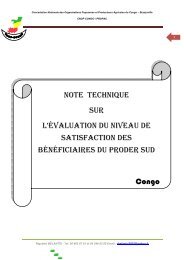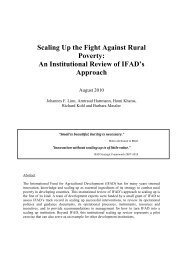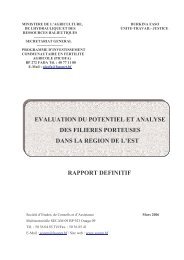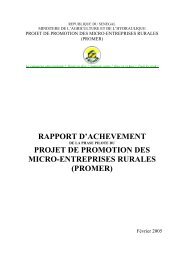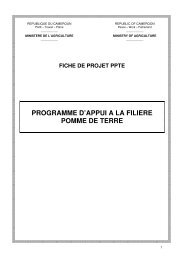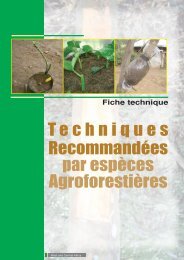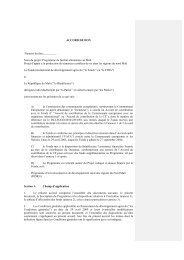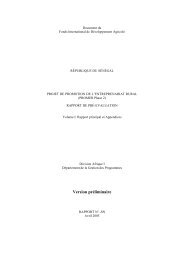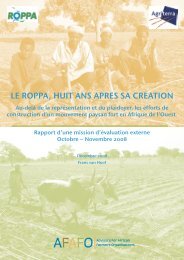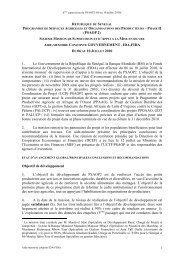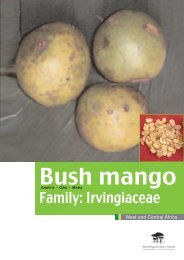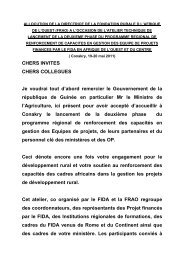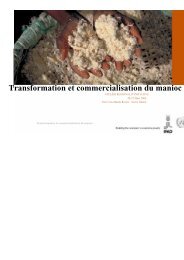CASSAVA OPPORTUNTIES IN NIGERIA - FAO.org
CASSAVA OPPORTUNTIES IN NIGERIA - FAO.org
CASSAVA OPPORTUNTIES IN NIGERIA - FAO.org
Create successful ePaper yourself
Turn your PDF publications into a flip-book with our unique Google optimized e-Paper software.
3 PROCESS<strong>IN</strong>G AND UTILIZATION<br />
3.1 CURRENT STATUS<br />
Cassava is a very versatile commodity with<br />
numerous uses and by products. Each component<br />
of the plant can be valuable to its cultivator. The<br />
leaves may be consumed as a vegetable, or<br />
cooked as a soup ingredient or dried and fed to<br />
livestock as a protein feed supplement. The stem<br />
is used for plant propagation and grafting. The<br />
roots are typically processed for human and<br />
industrial consumption. The Handbook lists the<br />
numerous uses of cassava in human consumption<br />
and industrial use.<br />
In Nigeria, the consumption pattern varies<br />
according to ecological zones (Table 3-1). Gari, a<br />
roasted granule is the dominant product and is<br />
widely accepted in both rural and urban areas. It<br />
can be consumed without any additives or it can<br />
be consumed with a variety of additives such as<br />
sugar, groundnut, fish, meat and stew.<br />
Table 3-1 Consumption Pattern by Zone and Cassava<br />
Product<br />
Zone 6 Order of importance<br />
South West Gari, Lafun, Fufu/Akpu<br />
South South Gari, Akpu<br />
South East Gari, Fufu/Akpu<br />
North Central Gari, Fufu/Akpu, Starch<br />
North East Fufu/Akpu, Gari, Abacha<br />
Fufu and Akpu, a fermented wet paste from<br />
cassava is also widely consumed throughout the<br />
country especially in the southern zones. Most<br />
processors however complain that the wet paste<br />
and ready to eat forms of fufu, that are currently<br />
sold, have a very short shelf life.<br />
Estimates of industrial cassava use suggest that<br />
approximately 16 percent of cassava root<br />
production was utilized as an industrial raw<br />
material in 2001 in Nigeria. Ten percent was used<br />
as chips in animal feed, 5 percent was processed<br />
into a syrup concentrate for soft drinks and less<br />
than one percent was processed into high quality<br />
6 Data were unavailable for the North West<br />
9<br />
cassava flour used in biscuits and confectionary,<br />
dextrin pre-gelled starch for adhesives, starch and<br />
hydrolysates for pharmaceuticals, and seasonings<br />
(Kormawa and Akoroda, 2003).<br />
This estimate leaves 84 percent or 28.9 million<br />
tonnes of production for food consumption, a<br />
portion of this of course being lost in post harvest<br />
and waste.<br />
Comparable time series data describing cassava<br />
processing and utilization at the national, regional<br />
and state level is virtually non-existent.<br />
Fortunately it was possible to obtain a preliminary<br />
analysis of the first national consumption survey<br />
of Nigeria since the early 1980s 7 (Ministry of<br />
Health and Nutrition of Nigeria, 2004).<br />
Table 3-2 illustrates daily cassava consumption<br />
per capita by geographic region. Surprisingly,<br />
urban and rural consumption are not dissimilar,<br />
confirming the fact that cassava is truly a national<br />
food with an urban market presence. Cassava<br />
appears to be a ‘food of choice’ even in the face<br />
of alternative food options in urban areas.<br />
Table 3-2 Daily Consumption of Cassava per capita<br />
Grams per Person per<br />
Day<br />
National 226.93<br />
Dry Savannah Zone 131.16<br />
Moist Savannah 192.37<br />
Humid Forest Zone 284.42<br />
Rural 239.74<br />
Medium 220.53<br />
Urban 213.76<br />
(Ministry of Health and Nutrition of Nigeria,<br />
2004)<br />
Assuming per capita urban consumption is 213.76<br />
gm of cassava per day, the rural micro, small and<br />
medium food processors is supplying 4 million<br />
metric tonnes of processed cassava product a<br />
year. This is equivalent to 6.6 million tonnes in<br />
cassava root. This estimate of cassava utilization<br />
is low given earlier estimates that work backwards<br />
7 The Cassava Handbook contains information on daily<br />
consumption by grams and frequency of cassava consumed<br />
per week by the states surveyed.



